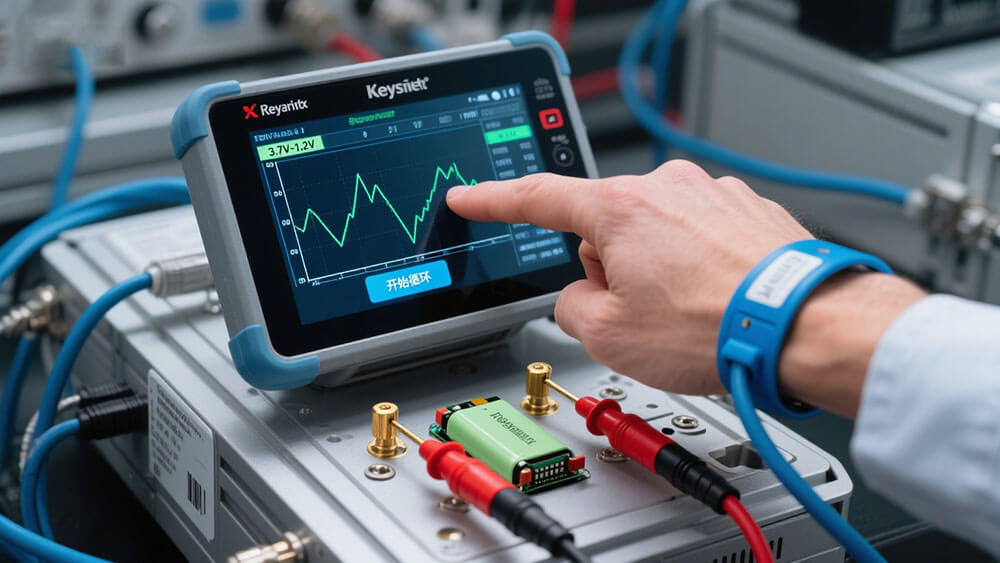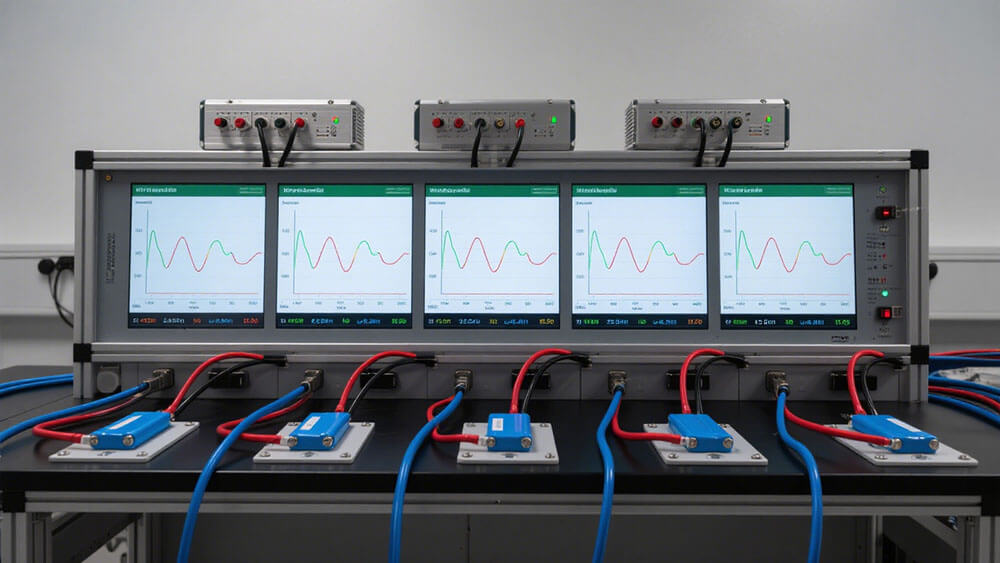
You now face new demands in energy storage as lithium-ion battery technology advances. Traditional battery monitoring system methods often fail to deliver actionable insights. With Cloud Analytics in Batteries, you gain a smarter battery monitoring system that leverages AI and real-time data. Modern BMS solutions use cloud platforms to analyze battery health, optimize energy storage, and strengthen reliability. This approach transforms batteries into active assets, allowing your battery monitoring system to predict failures and maximize battery technology efficiency. By harnessing cloud-powered data, you ensure your lithium-ion batteries support energy storage needs across every application.
Key Takeaways
Cloud analytics and AI transform battery monitoring by providing real-time data and predictive insights that improve reliability and extend battery life.
Modern battery management systems use intelligent thresholds and digital twins to adapt to changing needs, helping prevent failures and optimize energy storage.
Emerging trends like modular platforms and enhanced safety features make battery systems more scalable, secure, and ready for future energy demands.
Part 1: Battery Monitoring System Challenges

1.1 Manual Methods
You may still rely on manual methods to track battery health in your energy storage systems. These approaches often involve periodic checks, handwritten logs, and visual inspections. Manual tracking can lead to missed warning signs in batteries, especially in large-scale energy storage systems. When you manage multiple battery packs, manual processes make it difficult to collect consistent data. This lack of real-time information limits your ability to respond quickly to changes in battery performance. E.g., surgical interruptions due to delayed manual monitoring in medical devices, or data loss from battery failures in data centers (cite industry reports like IEEE White Paper on Energy Storage Safety). Analyze technical limitations: Reference standards like IEC 62443 to explain manual methods’ inability to meet real-time risk detection. In sectors like medical, robotics, and infrastructure, manual monitoring increases the risk of unexpected downtime and costly failures.
Tip: Automating your battery monitoring system helps you reduce human error and improve data accuracy.
1.2 Limited Predictive Power
Traditional battery monitoring system setups, including basic BMS, often lack predictive analytics. NASA or Wood Mackenzie data showing 30% false alarms in traditional BMS increasing operational costs. Tesla energy storage plant downtime losses ($500k/incident) due to prediction failures.You may only discover issues after a battery fails, which disrupts your energy storage operations. Without advanced data analysis, your battery management system cannot forecast capacity fade or remaining useful life. This limitation affects the reliability of energy storage systems in industrial, security, and consumer electronics applications. The table below compares manual and advanced BMS approaches:
Feature | Manual Methods | |
|---|---|---|
Data Collection | Infrequent | Continuous |
Predictive Analytics | None | Yes |
Real-Time Monitoring | No | Yes |
Scalability | Low | High |
You need a battery monitoring system that leverages real-time data and predictive analytics to optimize energy storage and extend battery life. Upgrading your BMS ensures your energy storage systems deliver reliable performance across all applications.
Part 2: Cloud Analytics in Batteries

2.1 Real-Time Data
You need real-time data to manage energy storage systems efficiently. Cloud analytics in batteries delivers this capability by connecting your battery monitoring system to the cloud. With cloud-based BMS, you can collect, store, and analyze data from every battery in your fleet. This approach gives you instant visibility into voltage, temperature, current, and State of Health (SoH) for each battery.
RUBY stands out as a leader in cloud analytics in batteries. Its AI-driven diagnostics process complex electrochemical data, much like facial recognition for batteries. You receive accurate SoH and Remaining Useful Life (RUL) estimates in real time. This level of insight allows you to optimize energy storage and prevent unexpected failures.
Note: Real-time data from cloud-based BMS supports proactive decision-making and helps you avoid costly downtime in medical, robotics, and infrastructure applications.
2.2 Predictive Maintenance
Predictive maintenance marks a major advancement in battery monitoring solutions. Traditional BMS often alerts you only after a problem occurs. Cloud-based BMS, powered by advanced analytics, changes this approach. You can now predict when a battery will need service or replacement before it fails.
RUBY’s cloud analytics in batteries uses AI to track capacity fade, temperature trends, and charge cycles. The system analyzes historical and real-time data to forecast RUL. This predictive power lets you schedule maintenance at the optimal time, reducing costs and extending battery life. You avoid unnecessary replacements and minimize risk in energy storage systems.
Here’s how cloud-based BMS compares to traditional BMS:
Feature | Traditional BMS | Cloud-Based BMS |
|---|---|---|
Data Collection | Local, limited | Cloud, scalable |
Real-Time Data | Basic | Comprehensive |
Predictive Maintenance | No | Yes |
Analytics | Minimal | Advanced |
Scalability | Low | High |
Actionable Insights | Limited | Extensive |
Tip: Predictive maintenance with cloud analytics in batteries helps you maximize uptime and reliability in industrial and consumer electronics energy storage systems.
2.3 Intelligent Thresholds
Intelligent thresholds represent a new level of innovation in battery monitoring system design. With cloud-based BMS, you can set dynamic pass/fail criteria based on your application’s needs. RUBY’s Intelligent Target Selector adjusts thresholds in real time, considering risk, demand, and operational context.
For example, if your energy storage systems face increased demand during a high-traffic event, the system raises the reserve charge threshold. This ensures only the healthiest batteries remain in service. If demand drops, the threshold relaxes, allowing more batteries to stay active. You gain flexibility and efficiency without sacrificing safety.
Cloud analytics in batteries empowers you to:
Adapt battery monitoring solutions to changing operational requirements.
Use data analysis to inform risk management strategies.
Visualize battery health with clear indicators for quick decision-making.
Alert: Intelligent thresholds in cloud-based BMS support advanced battery monitoring solutions for sectors like security, Medical, and infrastructure, where reliability is critical.
Cloud analytics in batteries transforms your approach to energy storage. You move from reactive maintenance to proactive management. You gain actionable insights, scalability, and the ability to optimize every battery in your fleet. This innovation drives advancements in battery technology and supports the future of sustainable energy storage systems. For custom solutions tailored to your needs, contact our experts.
Part 3: Emerging Trends

As you navigate the rapidly changing landscape of energy storage, you encounter new opportunities and challenges. The latest emerging trends in battery technology and battery management systems (BMS) are shaping how you approach reliability, safety, and efficiency. Let’s explore the most significant advancements driving innovation in lithium-ion batteries and energy storage.
3.1 Digital Twins
You can now leverage the power of the battery digital twin to transform your approach to energy storage management. Digital twins improve RUL prediction accuracy to 95% A battery digital twin is a virtual replica of a physical battery or battery pack. This technology uses real-time data from your BMS to simulate, predict, and optimize battery performance throughout its lifecycle.
With a battery digital twin, you gain:
Continuous monitoring of battery health and performance.
Predictive analytics for maintenance and replacement planning.
Early detection of anomalies and degradation patterns.
RUBY’s Intelligent Target Selector stands out as an example of adaptive, risk-based battery management. By integrating battery digital twin models, you can adjust thresholds dynamically based on operational risk and application needs. This approach ensures you maximize the value of your lithium-ion batteries while maintaining reliability.
Note: Digital twins support advanced energy storage strategies in sectors like medical, robotics, and infrastructure. You can read more about the science behind digital twins in Nature’s review.
Table: Benefits of Battery Digital Twin vs. Traditional BMS
Feature | Traditional BMS | Battery Digital Twin |
|---|---|---|
Real-Time Data | Yes | Yes |
Predictive Maintenance | Limited | Advanced |
Anomaly Detection | Basic | Proactive |
Lifecycle Optimization | No | Yes |
Customization | Low | High |
3.2 Modular Platforms
You see a clear shift toward modular platforms in energy storage. Modular BMS architectures allow you to scale your battery systems efficiently and adapt to changing requirements. This trend supports the integration of emerging battery technologies, such as NMC Lithium battery, LiFePO4 Lithium battery, and LCO Lithium battery, into diverse applications.
With modular platforms, you benefit from:
Flexible system expansion for growing energy storage needs.
Simplified maintenance and upgrades.
Seamless integration with IoT devices and cloud analytics.
IoT integration stands as a key driver of this trend. By connecting your BMS to IoT networks, you can collect and analyze data from every battery module in real time. This capability enables you to implement advanced anomaly detection and optimize energy allocation across your entire fleet.
Tip: Modular platforms help you future-proof your energy storage investments and support sustainable growth. Learn more about our approach to sustainability.
3.3 Safety and Cybersecurity
You must prioritize safety and cybersecurity as energy storage systems become more connected and complex. The emphasis on battery safety and reliability has never been greater, especially with the widespread adoption of lithium-ion batteries in critical sectors.
Key advancements in this area include:
Enhanced BMS algorithms for early fault detection and thermal management.
Advanced anomaly detection using AI and machine learning.
Robust cybersecurity protocols to protect data and prevent unauthorized access.
RUBY’s cloud analytics platform incorporates multi-layered safety features and real-time monitoring to address these challenges. The Intelligent Target Selector adapts to changing risk profiles, ensuring your batteries operate within safe parameters. This innovation supports compliance with industry standards and helps you avoid costly incidents.
Alert: The growing focus on lithium-ion battery safety and cybersecurity reflects the latest emerging trends in energy storage. You can read more about conflict minerals and responsible sourcing in our conflict minerals statement.
Table: Safety and Cybersecurity Features in Modern BMS
Feature | Legacy BMS | Modern Cloud-Based BMS |
|---|---|---|
Fault Detection | Manual | Automated, AI-driven |
Data Security | Basic | Advanced Encryption |
Remote Monitoring | Limited | Comprehensive |
Compliance Support | Minimal | Integrated |
You can see that the latest trends in battery technology and BMS design focus on adaptability, data-driven decision-making, and the emphasis on battery safety and reliability. By embracing these emerging trends, you position your organization at the forefront of energy storage innovation.
If you want to explore custom solutions for your energy storage needs, contact our experts for a consultation.
Part 4: Future of Battery Monitoring

4.1 Evolving Cloud Analytics
You see rapid changes in energy storage as cloud-based bms platforms evolve. These systems now process more data than ever before. You can monitor every battery in your fleet with real-time analytics. This approach helps you identify trends and optimize battery technology for your applications. Cloud-based bms platforms use AI to predict failures and extend battery life. You gain insights that support energy storage systems for electric vehicles and large-scale infrastructure.
Key benefits of evolving cloud-based bms include:
Real-time data collection and analysis for all batteries
Predictive analytics to reduce downtime
Scalable solutions for growing energy storage needs
Feature | Traditional BMS | Cloud-Based BMS |
|---|---|---|
Data Processing | Local | Cloud |
Analytics | Basic | Advanced |
Scalability | Limited | High |
Predictive Maintenance | No | Yes |
Tip: You can learn more about advanced bms features in our BMS operation guide.
4.2 Regulatory Developments
You must stay updated on new regulations as energy storage systems expand. The increasing adoption of electric vehicles drives stricter standards for battery technology and bms. You see new rules for data security, recycling, and safety in global markets. Cloud-based bms platforms help you comply by tracking data and generating reports for audits.
Recent trends in regulation focus on:
Data transparency for battery lifecycle management
Safety standards for lithium battery packs
Environmental rules for recycling and disposal
You can prepare for future changes by choosing cloud-based bms that support compliance. These systems help you manage energy storage and meet industry requirements. For more on sustainable practices, visit our sustainability page.
Alert: If you need custom solutions to meet regulatory demands, contact our experts for a consultation.
You gain a competitive edge when you use cloud analytics in your bms. This approach improves reliability, safety, and cost savings for every battery. AI-driven bms platforms like RUBY help you predict issues and optimize performance. As bms technology evolves, you see smarter diagnostics, better data, and more efficient battery management.
You increase reliability with real-time bms insights.
You reduce costs by using predictive bms maintenance.
You improve safety through advanced bms monitoring.
FAQ
1. What advantages does cloud analytics offer for lithium battery pack management?
You gain real-time insights, predictive maintenance, and scalable monitoring. Cloud analytics helps you optimize performance and extend battery life for your lithium battery packs.
2. How does RUBY’s Intelligent Target Selector improve battery safety?
RUBY’s Intelligent Target Selector dynamically adjusts thresholds based on operational risk. You ensure safe, efficient use of each lithium battery pack in your application.
3. How can you get a custom lithium battery solution from Large Power?
You can request a tailored consultation for your lithium battery pack needs by visiting Large Power’s custom battery solution page.






